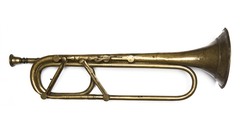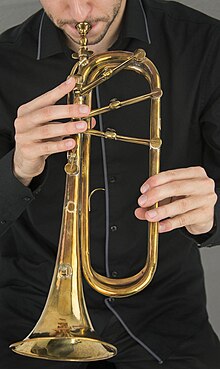 Keyed trumpet in G by Franz Stöhr, c. 1830. St Cecilia's Hall, Edinburgh Keyed trumpet in G by Franz Stöhr, c. 1830. St Cecilia's Hall, Edinburgh | |
| Brass instrument | |
|---|---|
| Other names | |
| Classification | brass |
| Hornbostel–Sachs classification | 423.211 (chromatic labrosone with keys and cylindrical bore) |
| Developed | Late 18th century |
| Related instruments | |
| Musicians | |
| |
| Builders | |
Historical:
| |
The keyed trumpet is a cylindrical-bore brass instrument in the trumpet family that makes use of tone holes operated by keys to alter pitch and provide a full chromatic scale, rather than extending the length of tubing with a slide or valves. It was developed from the natural trumpet in the 18th century and reached its high-point in popularity c. 1800 when two important trumpet concertos were written for it by Austrian composers Joseph Haydn and Johann Nepomuk Hummel, but waned with the invention of valves in the 1820s and the subsequent emergence of the modern valved trumpet. It is rarely seen in modern performances.
History

The idea of applying keys to the natural trumpet, in order to extend its available notes beyond the harmonic series, was first documented by Leonardo da Vinci as a series of annotated diagrams in his notebooks written c. 1480–1518. Da Vinci describes a mechanism using a wire or thin rod to link finger-operated buttons to remote keys or pads, allowing tone holes to be in their acoustically correct positions without having to be covered directly by the fingertips. Like many of his ideas, it was not realised for centuries.
The invention of the keyed trumpet is often attributed to Viennese court trumpeter Anton Weidinger, its most successful and earliest proponent, who was certainly involved in its early development and built one of the first prototypes. However further research has revealed many conflicting records, accounts, and details of surviving instruments that attest to its simultaneous independent invention in several places within a short period, such that the very first inventor may never be known with certainty. The lack of surviving instruments from this early period further obscures its history.
The very first designs of keyed trumpet were intended to correct the intonation of the notes in the harmonic series, rather than to extend its capabilities to a full chromatic scale. The harmonic trumpet, a silver trumpet in E♭ with crooks for D, C, and B♭ and four keys, was made by London instrument maker William Shaw for King George III in 1787. Eric Halfpenny found that each key corresponds to one of the four crooks and raises the pitch by a fifth, providing a fuller range of notes by allowing the player to switch between two harmonic series as required. This instrument not only predates Weidinger's instrument, but may have been known to Austrian composer Joseph Haydn, who was making extended visits to London at the time. He composed his trumpet concerto in 1796, the year after his last visit, and early music trumpet specialist Crispian Steele-Perkins postulates that this instrument, via Haydn, may have inspired the further development of keyed trumpets in Vienna by Weidinger and others.
The keyed trumpet's popularity peaked in the first decades of the 19th century, sustained by Weidinger and subsequent players throughout Europe. It unlocked the chromatic scale for trumpet players, increasing the versatility of the instrument and allowing its use in the orchestra as a featured, rather than background, instrument. Its popularity was relatively short-lived, remaining in frequent use until only the 1830s and 1840s, by which time the valved cornet à pistons was replacing it. This fate was shared by many other historical brass instruments that were replaced by their valved improvements, such as the serpent, early cimbasso, ophicleide, and keyed bugle.
Construction
The keyed trumpet has raised tone holes in the wall of the tubing, similar in construction to the later ophicleide or saxophone. These are closed by keys with pads, operated by the fingers via a rod and lever mechanism, similar to those used on woodwind instruments. The experimental E♭ keyed trumpet was not confined to the natural notes, but was chromatic in all registers of the instrument. Before this, the trumpet was commonly valveless and could only play the notes of the harmonic series by altering the lip tension and embouchure, a group of instruments referred to as natural or Baroque trumpets. These harmonic notes were clustered in the high registers, so previous trumpet concertos could only play melodies at very high pitches.
Repertoire

In 1796, Austrian composer Joseph Haydn wrote his Trumpet Concerto for Vienna court musician Anton Weidinger, who performed its première on 22 March 1800 at the Imperial and Royal Court Theatre. The piece begins with the broken triads and fanfare motifs common to trumpet music of the time (to amuse the audience who had come to see this exciting new kind of trumpet), but follows with chromatic runs and diatonic melodies not possible on the natural trumpet. This allows the concerto to be the first trumpet solo written in sonata-allegro form. The highest note in the concerto is high concert D♭, or high E♭ on a B♭ trumpet, or a high B♭ on E♭ trumpet for which it was written.
Like Haydn, Austrian composer Johann Nepomuk Hummel wrote his Trumpet Concerto for Anton Weidinger. It was written and performed in 1803 to mark his entrance into the Esterházy court orchestra in 1804, following Haydn. There are places, primarily in the second movement, where Weidinger is believed to have changed the music because of the execution of the instrument; it is unknown whether this was in agreement with Hummel.
Other works
Below is a list of pieces originally written to have keyed trumpet:
- Leopold Kozeluch - Concertante in E flat major for mandolin, keyed trumpet, double bass, pianoforte and orchestra - 1798
- Joseph Weigl - Concerto in E flat for Corno Inglese, Flauto d’amore, Tromba, Viola d’amore, Cembalo and Violoncello - 1799
- Johann Nepomuk Hummel - Trio for pianoforte, violin and trumpet. (possibly the influence for Rondo from Hummel’s trumpet concerto) - 1802
- Antonio Casimir Cartellieri - Polonaise in A - 1815
- Sigismund Neukomm - Requiem (with keyed trumpet interludes) - 1815
Performance

Due to its physical characteristics—cylindrical bore, bell shape, and historical mouthpiece—the keyed trumpet is closer in tone to the natural trumpet than the valved trumpet. Nevertheless, the combination of wide-flared bell and cylindrical bore introduces inherent acoustical problems when using tone holes, especially compared its conical-bore equivalent the keyed bugle. It was once said to have sounded like a "Demented Oboe... despite Haydn's efforts, the keyed trumpet had no real success- the explanation may be that the holes detracted from the brilliant tone of the instrument." The keyed trumpet has a different, weaker tone on open-keyed notes, due to the inability of the bell to support the harmonics produced when shortening the cylindrical air column. This inferior tone quality is ultimately what allowed the keyed trumpet to be surpassed by the valved trumpet.
There are few people that play the keyed trumpet today, and it is generally used only in historically informed performances. Modern experts on the keyed trumpet include Markus Wuersch, Mark Bennett and Barry Bauguess. Given that there are few people who can play this specialized instrument, performances are rare and almost exclusively performances of the Haydn or Hummel concertos. The argument for using keyed trumpets in the modern day is that you get the distinct tone qualities of the instrument. Keyed trumpets have a rich, overtone filled sound due to them being double the length of the modern trumpet. Today, orchestral music is seeing a push to return to period instruments in order to preserve the compositions in the way the composer intended. This push is what has caused instrument makers like Konrad Burri to revisit and produce period instruments like the keyed trumpet in the modern day.
Recordings
Although performances using the keyed trumpet are rare, there are a few recordings that can be listened to:
- Mark Bennett, Haydn Trumpet Concerto with The English Concert (1990)
- Markus Würsch, Hummel Trumpet Concerto (2016)
See also
References
- ^ da Vinci, Leonardo (1998) . "Codex Arundel, Arundel MS 263, ff.174v-175r". London: The British Library. Archived from the original on 25 June 2024. Retrieved 25 June 2024 – via Google Arts & Culture. Cited in Klaus (2013).
- Klaus 2013, p. 159.
- Warburton 1980, p. 76.
- Klaus 2013, p. 167.
- Klaus 2013, p. 160.
- Shaw, William (1787). "Trumpet". London: Royal Collection Trust. Accession: RCIN 72313. Archived from the original on 9 July 2024. Retrieved 26 June 2024.
- Klaus 2013, p. 161-162.
- ^ Russell, William (2008). "Background Research". The Keyed Trumpet. Archived from the original on 16 February 2023. Retrieved 1 March 2023.
- ^ Dahlqvist, Reine (2001). "Keyed trumpet". Grove Music Online (8th ed.). Oxford University Press. doi:10.1093/gmo/9781561592630.article.14950. ISBN 978-1-56159-263-0. Retrieved 16 February 2023.
- ^ Webb, John (1986). "19th-Century Keyed Brass". The Musical Times. 127 (1716): 83–85. doi:10.2307/964561. ISSN 0027-4666. JSTOR 964561. Archived from the original on 2023-02-16. Retrieved 2023-02-27.
- ^ Geiringer, K and Geiringer, I (1982) Haydn: A Creative Life in Music, p. 324-325
- Bauer, I. (1817). "Klappentrompete in G". Staatliche Museen zu Berlin. Accession: 1063. Archived from the original on 26 June 2024. Retrieved 26 June 2024.
- Klaus 2013, p. 188.
- "Trumpet Concerto in E-flat major, Hob.VIIe:1 (Haydn, Joseph) - IMSLP: Free Sheet Music PDF Download". imslp.org. Archived from the original on 16 February 2023. Retrieved 16 February 2023.
- Müller, Louis (2006) . "Keyed trumpet, nominal pitch: E♭". University of Edinburgh. Accession: 3158. Retrieved 26 June 2024.
- Klaus 2013, pp. 168–169.
- Curtis, Stanley (23 August 2013). "Interview with Baroque Trumpeter, Barry Bauguess". Trumpet Journey. Archived from the original on 29 June 2024. Retrieved 29 June 2024.
- "The Keyed Trumpet". Siouxland Public Media. 2015-10-15. Retrieved 16 February 2023.
- ^ Würsch, Markus (keyed trumpet); Burri, Konrad (instrument maker) (2022). The Keyed Trumpet – Newly Born (Video) (in German). Zimmerwald: Dingo And Fox Productions. Archived from the original on 16 February 2023. Retrieved 16 February 2023 – via YouTube. Subtitles in English.
- Bennett, Mark (keyed trumpet); The English Concert; Pinnock, Trevor (conductor); Haydn, Joseph (composer). Haydn: Concerto for Trumpet and Orchestra in E♭ major (CD Recording). Archiv Produktion. Catalog E4316782. Retrieved 16 February 2023 – via YouTube.
- Würsch, Markus (keyed trumpet); Bieler Kammerorchester / Orchestre de Chambre de Bienne; Mast, Beda (conductor); Hummel, Johann Nepomuk (composer). Markus Würsch performs Hummel Trumpet Concerto in E Major (Video). Dingo And Fox Productions. Archived from the original on 16 February 2023. Retrieved 16 February 2023 – via YouTube.
Bibliography
- Klaus, Sabine Katharina (2013). Ways to Expand the Harmonic Series. Trumpets and Other High Brass. Vol. 2. Vermillion: National Music Museum. ISBN 978-0-984-82692-6. Wikidata Q116447957.
- Warburton, Annie O. (1980). Analyses of Musical Classics. Vol. 2. ISBN 978-0-582-32484-8. OCLC 930237837. OL 6797765W. Wikidata Q126900650.
External links
 Media related to Keyed trumpets at Wikimedia Commons
Media related to Keyed trumpets at Wikimedia Commons- Keyed trumpets in the Joe R. and Joella F. Utley Collection of Brass Instruments at the National Music Museum
- thekeyedtrumpet.co.uk - a website dedicated to the keyed trumpet
| Trumpets and cornets | |
|---|---|
| By range | Contrabass > Bass > Standard > Soprano > Piccolo |
| Variants | |
| Parts and technique | |
| Other | |